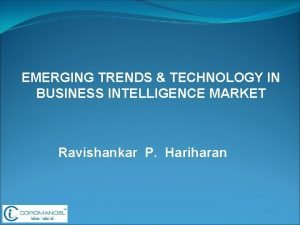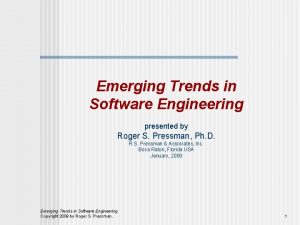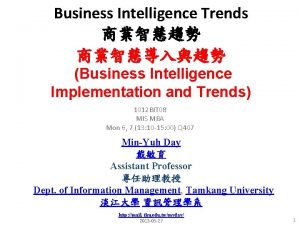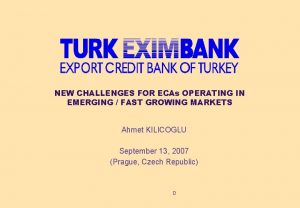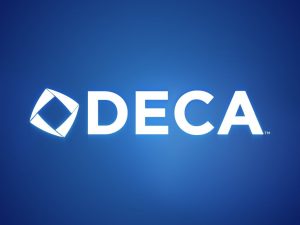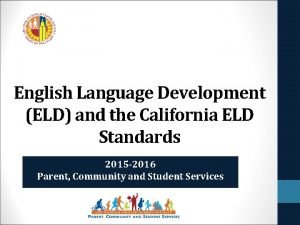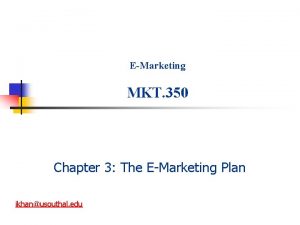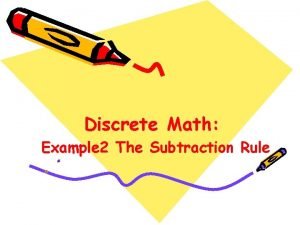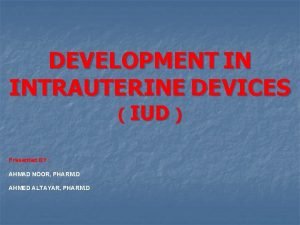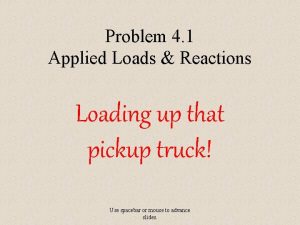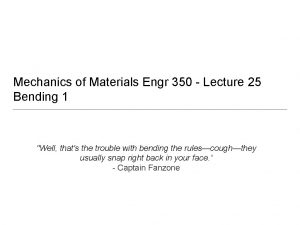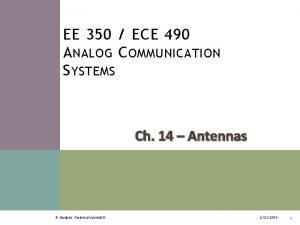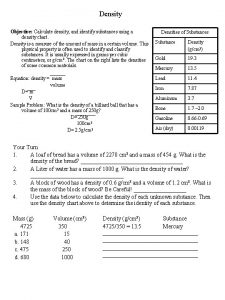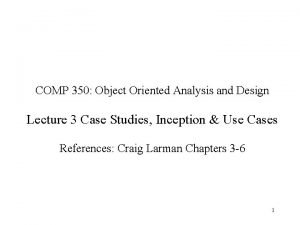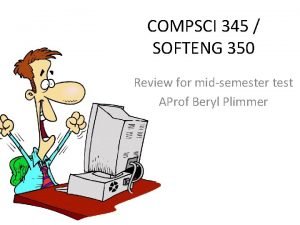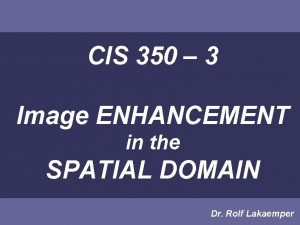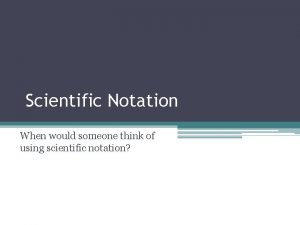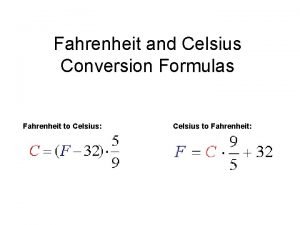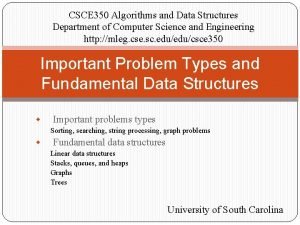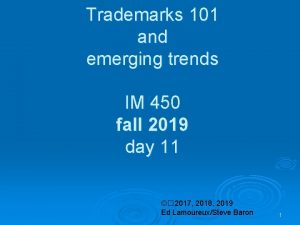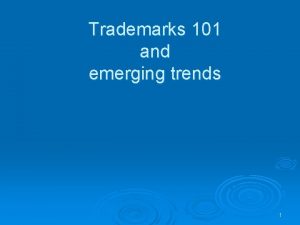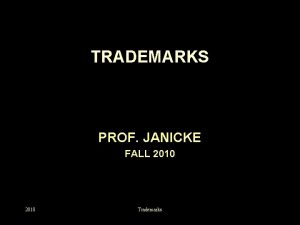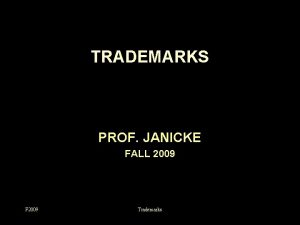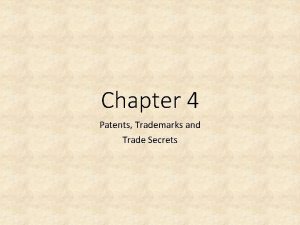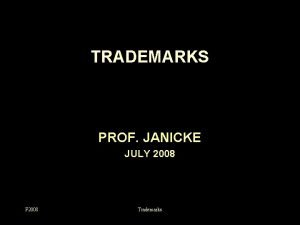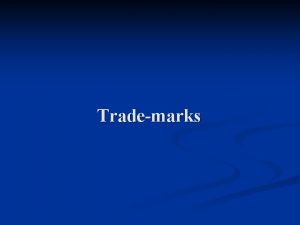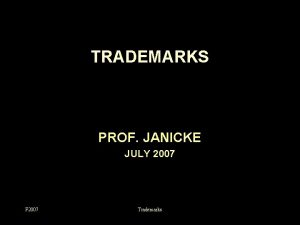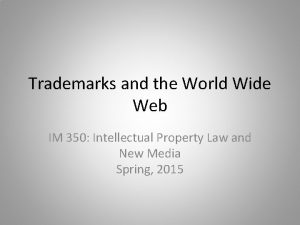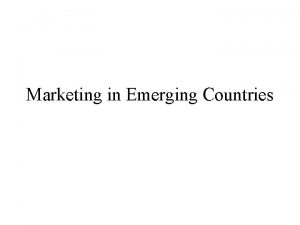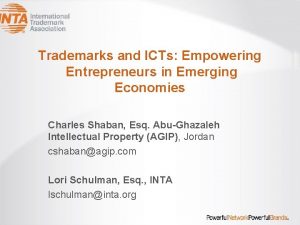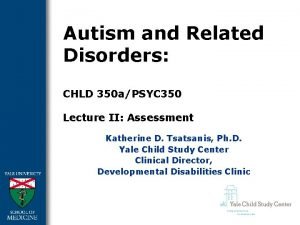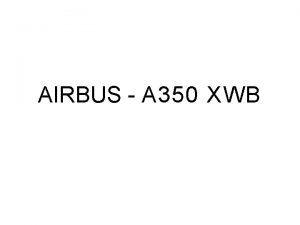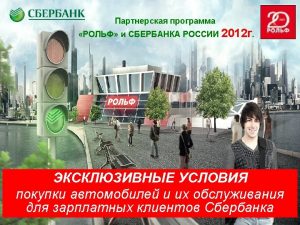Trademarks 101 and emerging trends IM 350 fall



















































- Slides: 51

Trademarks 101 and emerging trends IM 350 fall 2015 day 10 Sept. 29, 2015 1

I am here and using a working clicker True B. False A.

is a trademark. B. service mark. C. word mark. D. all of the above. A.

In order to be protected by law, a trademark A. B. C. D. must be registered at the state or federal level. must be used in commerce in a particular geographic area. must match the design submitted for registration. all of the above.

One may use the symbol ® as soon as one uses the trademark in commerce in a particular geographic area. B. only after filing a trademark application. C. only after a trademark application is registered by the appropriate governmental agency. D. none of the above. A.

One may use the symbol ™ as soon as one uses the trademark in commerce in a particular geographic area. B. only after filing a trademark application. C. only after a trademark application is registered by the appropriate governmental agency. D. none of the above. A.

Which hierarchy is correct, from least distinctive to most distinctive mark (left to right, first to last) A. fanciful, arbitrary, suggestive, descriptive, generic. B. generic, descriptive, suggestive, arbitrary, fanciful. C. arbitrary, fanciful, suggestive, generic, descriptive. D. none of the above

When a big “junior” trademark user saturates the market and overwhelms a small “senior” user the infringement is forward. B. initial interest. C. post-sale. D. reverse. A.

The Anti-Cybersquatting Consumer Protection Act considers the following to be indicative of “a bad faith intent to profit” from marks: A. B. C. D. offer to transfer domain name to the mark owner or any third party for financial gain without having used or intended to use domain name to offer goods or services. provision of false contact information when applying for the registration of the domain name. registration or acquisition of multiple domain names which the person knows are identical or confusingly similar to marks of others that are distinctive at the time of registration of such domain names. all of the above.

The application fee for each new Generic Top-Level Domain Designation is: A. $8, 500 B. $185, 000 C. $85, 000 D. none of the above

A trademark is a word, phrase, symbol or design, or a combination of words, phrases, symbols or designs, that identifies and distinguishes the source of the goods of one party from those of others. • Trademarks are granted in specific categories • Trademarks are granted in geographic areas 11

A service mark is the same as a trademark, except that it identifies and distinguishes the source of a service rather than a product. 12

Kodak Ø Exxon Ø Coca Cola Ø Mc Donald’s Ø Starbucks Ø Walmart Ø MTV Ø Victoria’s Secret Ø Polaroid Ø Xerox Ø Lego Ø Beanie Babies Ø Kraft Ø Playboy Ø Apple Ø Dell Ø 13

14

Before using a mark, or applying to register one, you should search to see if it’s already registered for use Ø Trademark Searches www. uspto. gov l Private search firms • Will pick up “common law” uses • Can be expensive ($400 - $500) per mark searched l 15

Trademark Official Gazette Ø (TMOG) is published each Tuesday and contains bibliographic information and a representative drawing for each mark published, along with a list of cancelled and renewed registrations. Ø http: //www. uspto. gov/learning-andresources/official-gazette/trademarkofficial-gazette-tmog Ø The TMOG is searchable. 16

17

18

19

20

How do I acquire trademark rights? Ø From use of the mark in commerce Within a particular segment of the economy (as defined by the Trademark office) l Within a specified geographic area (as specified by where you do business and/or the area for which you apply) l 21

What is use in commerce? Ø For goods: the mark must appear on the goods, the container for the goods, or displays associated with the goods, and the goods must be sold or transported in commerce. 22

What is use in commerce? Ø For services: the mark must be used or displayed in the sale or advertising of the services, and the services must be rendered in commerce. Ø Again, the economic niche(s) and geographic area(s) in question. 23

Trademarks cannot ØBe reserved (for future use) l Although, there is an “intent to use” process for marks that are going to be used in commerce, but that have not yet been so used; 12 month “hold” by registration. ØProtect ideas 24

Fa Marks Must Be nc ifu “Distinctive” l. A rb itr ar y. S ug ge st ive De sc rip tiv e. G en er ic/ n Ge ne ric /y 25

Mark Must Be “Distinctive” Fanciful (Exxon) Ø Arbitrary (Apple) Ø Suggestive (Coca-Cola) Ø Descriptive (Expert Plumbers) Ø Generic yes (Xerox) l When a trademark from “above” category falls into “Generic, ” there is a risk of loss of rights. Xerox and Kleenex (for example) have to fight hard to protect their marks. Ø Generic no (Tissues) Ø 26

Is registration of a mark required? 27

No. You can establish rights in a mark based on legitimate use of the mark in commerce. 28

Why Register? Ø constructive notice to the public of the registrant's claim of ownership of the mark; Ø a legal presumption of the registrant's ownership of the mark and the registrant's exclusive right to use the mark nationwide on or in connection with the goods and/or services listed in the registration; 29

Why Register? the ability to bring an action concerning the mark in federal court; Ø the use of the U. S registration as a basis to obtain registration in foreign countries; and Ø the ability to file the U. S. registration with the U. S. Customs Service to prevent importation of infringing foreign goods. Ø 30

Where to Register? Ø State Registrations l l Cheaper (Illinois = $15) Statewide protection Ø Federal Registrations l The cost to apply for a U. S. trademark is now $325 per class of goods and services (if you use the electronic filing system). It may be even lower ($275) if the applicant uses a pre-ordained description of good and services 31

When can I use the trademark symbols TM and SM? Ø Any time you claim rights in a mark, you may use the "TM" (trademark) or "SM" (service mark) designation to alert the public to your claim, regardless of whether you have filed an application with the USPTO. 32

When can I use the trademark symbol ®? Ø You may use the federal registration symbol "®" only after the USPTO actually registers a mark, and not while an application is pending. Also, you may use the registration symbol with the mark only on or in connection with the goods and/or services listed in the federal trademark registration. 33

What must an application include? l l l the name of the applicant; a name and address for correspondence; a clear drawing of the mark; a listing of the goods or services; and the filing fee for at least one class of goods or services. 34

How long does a federal trademark last? 10 years l Renewable for successive 10 year periods l After 5 years, with proper filings, mark becomes “incontestable” l 35

Trademark Infringement and Dilution 36

What is a trademark Infringement? Ø Senior user owns mark Ø Junior user begins to use the same or similar mark on the same or similar goods or services Ø Likelihood of confusion in market 37

Who is the law protecting? Ø Consumers The public’s right not to be confused Ø Mark owners l The right to develop brand awareness l The right to prevent free-loaders from trading on the mark owner’s good will and reputation in the market place l 38

What laws apply? Ø Federal Statutes The Lanham Act • 15 U. S. C. §§ 1051 - 1127 Ø State Statutes l Counterfeit Trademark Act • 765 ILCS 1049 l http: //www. legis. state. il. us/legisl ation/ilcs/ch 765 act 1040. ht m Ø Judicial Decisions 39 l

Likelihood of Confusion Factors Ø Similarity of the Marks Ø Similarity of the Products Ø Area and Manner of Concurrent Use Ø Degree of Care Exercised by Consumers Ø Strength of Plaintiff’s Mark Ø Actual Confusion Ø Intent of Defendants 40

Types of Confusion Forward l Small Junior trades off of Big Senior User Ø Reverse l Big Junior saturates market and overwhelms Small Senior User Ø Initial Interest l Confusion that creates an initial customer interest (e. g. meta-tags, domain names) Ø Post-Sale l Confusion of someone other than purchaser Ø 41

Anticybersquatting Consumer Protection Act (ACPA) Ø Enacted in 1999 Ø Addresses the problem of domain name hi-jackers 42

Liability Under ACPA Ø Bad faith intent to profit from mark Ø Register, traffic in or use a domain name that: 43

Liability Under ACPA (I) in the case of a mark that is distinctive at the time of registration of the domain name, is identical or confusingly similar to that mark; Ø (II) in the case of a famous mark that is famous at the time of registration of the domain name, is identical or confusingly similar to or dilutive of that mark; or Ø (III) is a trademark, word, or name protected by reason of section 706 of title 18 or section 220506 of title 36. Ø 44

“Bad Faith” Elements under ACPA Ø (1) trademark or other IP rights in domain name; Ø (2) domain name consists of legal name of person or name used to identify person; Ø (3) person's prior use of domain name in connection with offer of goods or services; Ø (4) person's noncommercial or fair use of the mark in site; 45

“Bad Faith” Elements under ACPA Ø (5) intent to divert consumers from the mark owner's online location to a site accessible under the domain name; Ø (6) offer to transfer domain name to the mark owner or any third party for financial gain without having used or intended to use domain name to offer goods or services; Ø (7) provision of false contact information when applying for the registration of the domain name; 46

“Bad Faith” Elements under ACPA Ø (8) registration or acquisition of multiple domain names which the person knows are identical or confusingly similar to marks of others that are distinctive at the time of registration of such domain names; Ø (9) the extent to which the mark incorporated in the domain name registration is or is not distinctive and famous within the meaning of subsection (c)(1) of this section. 47

Domains v. Search Terms The protection afforded trademarks as URLs/domain names is not afforded/extended to the use of trademarks as search terms. Generally, the courts have not limited the use of trademarks as search terms (or the related auctions and commerce that goes with them). This could change someday (and maybe threaten Mr. Giggle) 48

Trademark Dilution Ø Lessening of a famous mark to identify and distinguish goods and services Ø Irrespective of: l l Competition between owner of mark and other parties; or Likelihood of confusion, mistake or deception 49

Trademark Dilution Ø “Blurring” distinctiveness of mark Ø “Tarnishing” reputation of mark 50

Top Trends In Trademark Ø Ø Ø steady growth in the numbers of trademark applications new generic Top-Level Domain designations (g. TLD) use of trademarks by celebrities and in politics trademarks in search and keyword advertising using trade dress to protect website designs, inappropriate uses of trademarks in virtual worlds.
 Emerging issues in community development in kenya
Emerging issues in community development in kenya Emerging trends in business intelligence
Emerging trends in business intelligence Emerging trends in software engineering ppt
Emerging trends in software engineering ppt Emerging trends in business intelligence implementation
Emerging trends in business intelligence implementation Emerging trends in strategic management
Emerging trends in strategic management Emerging trends in society
Emerging trends in society Challenges of emerging trends in operating systems
Challenges of emerging trends in operating systems Emerging trends in disaster management
Emerging trends in disaster management Mis trends
Mis trends What is deca's mission
What is deca's mission Emerging technology chapter 5
Emerging technology chapter 5 The byzantine empire and emerging europe
The byzantine empire and emerging europe It infrastructure and emerging technologies
It infrastructure and emerging technologies Emerging bridging expanding
Emerging bridging expanding Chapter 9 emerging europe and the byzantine empire
Chapter 9 emerging europe and the byzantine empire It infrastructure and emerging technologies
It infrastructure and emerging technologies Emerging technology chapter 5
Emerging technology chapter 5 Computer hardware platforms in it infrastructure
Computer hardware platforms in it infrastructure Jeffrey arnett emerging adulthood theory
Jeffrey arnett emerging adulthood theory Emerging media definition
Emerging media definition Emerging database technologies and applications
Emerging database technologies and applications Emerging database
Emerging database Byzantine definition
Byzantine definition A car uses 2 500 joules in 25 seconds. find power
A car uses 2 500 joules in 25 seconds. find power Ptt-350
Ptt-350 Ptt-350
Ptt-350 Functions of the pericardium
Functions of the pericardium Rumus jarak berpapasan
Rumus jarak berpapasan Mkt 350
Mkt 350 Subtraction rule example
Subtraction rule example Fincoid 350
Fincoid 350 Dropbox csce
Dropbox csce Csce 350 tamu
Csce 350 tamu 350-170-120
350-170-120 Cisco aironet 350
Cisco aironet 350 Xp-67
Xp-67 Delia purchased a new car
Delia purchased a new car %50 eksiği 60 olan sayı kaçtır
%50 eksiği 60 olan sayı kaçtır Fick ptt
Fick ptt Two crates each of mass 350 kg
Two crates each of mass 350 kg Engr 350
Engr 350 Alvear y cardeza 350
Alvear y cardeza 350 Ece 490
Ece 490 4725/350
4725/350 Comp 350
Comp 350 350 forts in maharashtra
350 forts in maharashtra Da pam 350-20
Da pam 350-20 Softeng 350
Softeng 350 Cis 350
Cis 350 Express 586 400 000 in scientific notation
Express 586 400 000 in scientific notation Fahrenheit equation
Fahrenheit equation Csce 350
Csce 350

